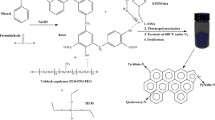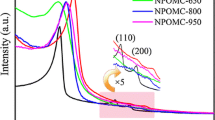Abstract
Ordered mesoporous carbon (CMK-3) was fabricated by a simple nanocasting method using SBA-15 as a hard template. The CMK-3 had a two-dimensional hexagonal mesoporous structure and a specific surface area of approximately 975.9 m2 g−1. The CMK-3 was modified by HNO3 solutions with magnetic stirring and ultrasonic activation, respectively, to explore the influence of various activation methods on pore structure, surface state, morphology, and electrochemical performance. The CMK-3 modified by ultrasonic activation (CMK-3-US) reached the optimal specific capacitance of 233.4 A g−1 at 0.5 A g−1 and retained 94.2% after 500 cycles in 3 M KOH electrolyte. Furthermore, a symmetric supercapacitor was successfully assembled using CMK-3-US electrodes, which delivered an excellent energy density of 21.5 Wh kg−1 at a power density of 225 W kg−1 and exhibited great long-term stability with 97.5% retention after 4000 cycles. Compared to magnetic stirring activation, ultrasonic cavitation could better increase the efficiency of the HNO3 activation for mesoporous carbon particles. The results indicate ultrasonic activation is an efficient way to modify carbon-based electrode materials for supercapacitors.







Similar content being viewed by others
References
Gao D, Wang L, Wang C, Wei Q (2015) Electrospinning of porous carbon nanocomposites for supercapacitor. Fibers Polym 16(2):421–425. doi:10.1007/s12221-015-0421-2
Hasegawa G (2013) Monolithic electrode for electric double-layer capacitors based on macro/meso/microporous s-containing activated carbon with high surface area. In: Studies on porous monolithic materials prepared via sol–gel processes, Springer theses, Springer, Tokyo, Japan, pp 79–89. doi:10.1007/978-4-431-54198-1_6
Liu H-J, Wang X-M, Cui W-J, Dou Y-Q, Zhao D-Y, Xia Y-Y (2010) Highly ordered mesoporous carbon nanofiber arrays from a crab shell biological template and its application in supercapacitors and fuel cells. J Mater Chem 20(20):4223–4230. doi:10.1039/b925776d
Guo R, Lin R, Yue W, Ma H (2015) Enhanced electrochemical performance of mesoporous carbon with increased pore size and decreased pore wall thickness. Electrochim Acta 174:1050–1056. doi:10.1016/j.electacta.2015.06.113
Li H-Q, Liu R-L, Zhao D-Y, Xia Y-Y (2007) Electrochemical properties of an ordered mesoporous carbon prepared by direct tri-constituent co-assembly. Carbon 45(13):2628–2635. doi:10.1016/j.carbon.2007.08.005
Redondo E, Carretero-González J, Goikolea E, Ségalini J, Mysyk R (2015) Effect of pore texture on performance of activated carbon supercapacitor electrodes derived from olive pits. Electrochim Acta 160:178–184. doi:10.1016/j.electacta.2015.02.006
Cao L, Kruk M (2010) A family of ordered mesoporous carbons derived from mesophase pitch using ordered mesoporous silicas as templates. Adsorption 16(4):465–472. doi:10.1007/s10450-010-9248-8
Ryoo R, Joo SH, Jun S (1999) ChemInform abstract: synthesis of highly ordered carbon molecular sieves via template-mediated structural transformation. ChemInform. doi:10.1002/chin.199950233
Lee J, Yoon S, Hyeon TM, Oh S, Bum Kim K (1999) Synthesis of a new mesoporous carbon and its application to electrochemical double-layer capacitors. Chem Commun 21:2177–2178. doi:10.1039/a906872d
Jun S, Joo SH, Ryoo R, Kruk M, Jaroniec M, Liu Z, Ohsuna T, Terasaki O (2000) Synthesis of new, nanoporous carbon with hexagonally ordered mesostructure. J Am Chem Soc 122(43):10712–10713. doi:10.1021/ja002261e
Pandolfo AG, Hollenkamp AF (2006) Carbon properties and their role in supercapacitors. J Power Sources 157(1):11–27. doi:10.1016/j.jpowsour.2006.02.065
Xia K, Gao Q, Jiang J, Hu J (2008) Hierarchical porous carbons with controlled micropores and mesopores for supercapacitor electrode materials. Carbon 46(13):1718–1726. doi:10.1016/j.carbon.2008.07.018
Li H, Ha Xi, Zhu S, Wen Z, Wang R (2006) Preparation, structural characterization, and electrochemical properties of chemically modified mesoporous carbon. Microporous Mesoporous Mater 96(1–3):357–362. doi:10.1016/j.micromeso.2006.07.021
Wilson BE, He S, Buffington K, Rudisill S, Smyrl WH, Stein A (2015) Utilizing ionic liquids for controlled N-doping in hard-templated, mesoporous carbon electrodes for high-performance electrochemical double-layer capacitors. J Power Sources 298:193–202. doi:10.1016/j.jpowsour.2015.08.057
Li Y-T, Pi Y-T, Lu L-M, Xu S-H, Ren T-Z (2015) Hierarchical porous active carbon from fallen leaves by synergy of K2CO3 and their supercapacitor performance. J Power Sources 299:519–528. doi:10.1016/j.jpowsour.2015.09.039
Zhu T, Lu Y, Zheng S, Chen Y, Guo H (2015) Influence of nitric acid activation on structure and capacitive performances of ordered mesoporous carbon. Electrochim Acta 152:456–463. doi:10.1016/j.electacta.2014.11.161
Solovyov LA, Shmakov AN, Zaikovskii VI, Joo SH, Ryoo R (2002) Detailed structure of the hexagonally packed mesostructured carbon material CMK-3. Carbon 40(13):2477–2481. doi:10.1016/S0008-6223(02)00160-4
Minchev C, Huwe H, Tsoncheva T, Dimitrov M, Paneva D, Mitov I, Froba M (2004) Effect of support pore size on the structural and catalytic properties of iron and cobalt oxides modified SBA-1, SBA-15, MCM-41 and MCM-48 silica materials. In: VanSteen E, Claeys M, Callanan LH (eds) Recent advances in the science and technology of zeolites and related materials, Pts a–c, vol 154., Studies in surface science and catalysisElsevier Science Bv, Amsterdam, pp 841–847
Zhao Y-Q, Lu M, Tao P-Y, Zhang Y-J, Gong X-T, Yang Z, Zhang G-Q, Li H-L (2016) Hierarchically porous and heteroatom doped carbon derived from tobacco rods for supercapacitors. J Power Sources 307:391–400. doi:10.1016/j.jpowsour.2016.01.020
Y-g Wang, Cheng L, Li F, H-m Xiong, Y-y Xia (2007) High electrocatalytic performance of Mn3O4/Mesoporous carbon composite for oxygen reduction in alkaline solutions. Chem Mater 19(8):2095–2101. doi:10.1021/cm062685t
Zhao D, Huo Q, Feng J, Chmelka BF, Stucky GD (1998) Nonionic Triblock and Star Diblock copolymer and oligomeric surfactant syntheses of highly ordered, hydrothermally stable, mesoporous silica structures. J Am Chem Soc 120(24):6024–6036. doi:10.1021/ja974025i
Hsu H-L, Jehng J-M, Sung Y, Wang L-C, Yang S-R (2008) The synthesis, characterization of oxidized multi-walled carbon nanotubes, and application to surface acoustic wave quartz crystal gas sensor. Mater Chem Phys 109(1):148–155. doi:10.1016/j.matchemphys.2007.11.006
Khomenko V, Raymundo-Piñero E, Béguin F (2010) A new type of high energy asymmetric capacitor with nanoporous carbon electrodes in aqueous electrolyte. J Power Sources 195(13):4234–4241. doi:10.1016/j.jpowsour.2010.01.006
Yuan X, Xu S, Lü J, Yan X, Hu L, Xue Q (2011) Facile synthesis of ordered mesoporous γ-alumina monoliths via polymerization-based gel-casting. Microporous Mesoporous Mater 138(1–3):40–44. doi:10.1016/j.micromeso.2010.09.033
Bazuła PA, Lu A-H, Nitz J-J, Schüth F (2008) Surface and pore structure modification of ordered mesoporous carbons via a chemical oxidation approach. Microporous Mesoporous Mater 108(1–3):266–275. doi:10.1016/j.micromeso.2007.04.008
Zhang J, Kong L-B, Cai J-J, Li H, Luo Y-C, Kang L (2010) Hierarchically porous nickel hydroxide/mesoporous carbon composite materials for electrochemical capacitors. Microporous Mesoporous Mater 132(1–2):154–162. doi:10.1016/j.micromeso.2010.02.013
Paiva MC, Zhou B, Fernando KAS, Lin Y, Kennedy JM, Sun YP (2004) Mechanical and morphological characterization of polymer–carbon nanocomposites from functionalized carbon nanotubes. Carbon 42(14):2849–2854. doi:10.1016/j.carbon.2004.06.031
Qi H, Zhang C, Li X (2006) Amperometric third-generation hydrogen peroxide biosensor incorporating multiwall carbon nanotubes and hemoglobin. Sens Actuators B 114(1):364–370. doi:10.1016/j.snb.2005.06.002
Wang J, Zhu M, Outlaw RA, Zhao X, Manos DM, Holloway BC (2004) Synthesis of carbon nanosheets by inductively coupled radio-frequency plasma enhanced chemical vapor deposition. Carbon 42(14):2867–2872. doi:10.1016/j.carbon.2004.06.035
Li M, Li W, Liu S (2011) Hydrothermal synthesis, characterization, and KOH activation of carbon spheres from glucose. Carbohydr Res 346(8):999–1004. doi:10.1016/j.carres.2011.03.020
Jiang J, Zhang L, Wang X, Holm N, Rajagopalan K, Chen F, Ma S (2013) Highly ordered macroporous woody biochar with ultra-high carbon content as supercapacitor electrodes. Electrochim Acta 113:481–489. doi:10.1016/j.electacta.2013.09.121
Su F, Zeng J, Bao X, Yu Y, Lee JY, Zhao XS (2005) Preparation and characterization of highly ordered graphitic mesoporous carbon as a pt catalyst support for direct methanol fuel cells. Chem Mater 17(15):3960–3967. doi:10.1021/cm0502222
Yang L, Hou LR, Zhang YW, Yuan CZ (2013) Facile synthesis of mesoporous carbon nanofibres towards high-performance electrochemical capacitors. Mater Lett 97:97–99. doi:10.1016/j.matlet.2012.12.018
J-w Lang, X-b Yan, W-w Liu, R-t Wang, Q-j Xue (2012) Influence of nitric acid modification of ordered mesoporous carbon materials on their capacitive performances in different aqueous electrolytes. J Power Sources 204:220–229. doi:10.1016/j.jpowsour.2011.12.044
Du Q, Zheng M, Zhang L, Wang Y, Chen J, Xue L, Dai W, Ji G, Cao J (2010) Preparation of functionalized graphene sheets by a low-temperature thermal exfoliation approach and their electrochemical supercapacitive behaviors. Electrochim Acta 55(12):3897–3903. doi:10.1016/j.electacta.2010.01.089
Khomenko V, Raymundo-Piñero E, Béguin F (2010) A new type of high energy asymmetric capacitor with nanoporous carbon electrodes in aqueous electrolyte. J Power Sources 195(13):4234–4241. doi:10.1016/j.jpowsour.2010.01.006
Bichat MP, Raymundo-Piñero E, Béguin F (2010) High voltage supercapacitor built with seaweed carbons in neutral aqueous electrolyte. Carbon 48(15):4351–4361. doi:10.1016/j.carbon.2010.07.049
Wang D-W, Li F, Liu M, Lu GQ, Cheng H-M (2008) 3D Aperiodic hierarchical porous graphitic carbon material for high-rate electrochemical capacitive energy storage. Angew Chem Int Ed 47(2):373–376. doi:10.1002/anie.200702721
Fuertes AB, Lota G, Centeno TA, Frackowiak E (2005) Templated mesoporous carbons for supercapacitor application. Electrochim Acta 50(14):2799–2805. doi:10.1016/j.electacta.2004.11.027
Zhou G, Wang D-W, Yin L-C, Li N, Li F, Cheng H-M (2012) Oxygen bridges between nio nanosheets and graphene for improvement of lithium storage. ACS Nano 6(4):3214–3223. doi:10.1021/nn300098m
Ma Y, Zhang C, Ji G, Lee JY (2012) Nitrogen-doped carbon-encapsulation of Fe3O4 for increased reversibility in Li+ storage by the conversion reaction. J Mater Chem 22(16):7845–7850. doi:10.1039/c2jm30422h
Acknowledgements
This study is primarily supported by Shanghai Eastern-scholar program.
Author information
Authors and Affiliations
Corresponding author
Rights and permissions
About this article
Cite this article
He, Z., Zhang, G., Chen, Y. et al. The effect of activation methods on the electrochemical performance of ordered mesoporous carbon for supercapacitor applications. J Mater Sci 52, 2422–2434 (2017). https://doi.org/10.1007/s10853-016-0536-x
Received:
Accepted:
Published:
Issue Date:
DOI: https://doi.org/10.1007/s10853-016-0536-x




